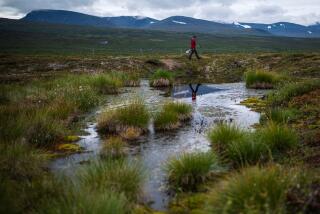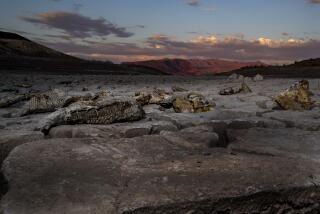Arctic Warming Is Drying Up Lakes, Study Finds
- Share via
An accelerating Arctic warming trend over the past quarter of a century has dramatically dried up more than a thousand large lakes in Siberia, probably because the permafrost beneath them has begun to thaw, according to a paper to be published today in the journal Science.
Comparing satellite images made in the early 1970s to those from recent years, a team of U.S. scientists determined that the number of large lakes in a vast 200,000-square-mile region of Russia’s Siberia diminished by about 11%, from 10,882 to 9,712.
For the record:
12:00 a.m. June 4, 2005 For The Record
Los Angeles Times Saturday June 04, 2005 Home Edition Main News Part A Page 2 National Desk 1 inches; 35 words Type of Material: Correction
Arctic lakes -- An article in Friday’s Section A about a study of shrinking Arctic lakes described Laurence C. Smith as an associate professor of geology at UCLA. He is an associate professor of geography.
About 125 of the 1,170 shrunken lakes disappeared altogether, and most are now considerably smaller than the study’s baseline of 40 hectares, or about 99 acres, the researchers found.
If Arctic temperatures continue to rise, the scientists said, many of the lakes in high northern latitudes, where they are ubiquitous, could eventually disappear.
“An 11% decline may not sound like much, but in the time-scale in which landscapes naturally change, this is extraordinarily fast,” said the paper’s lead author, Laurence C. Smith, an associate geology professor at UCLA.
Smith conducted the research with UCLA colleague Glen M. MacDonald, Yongwei Sheng of the State University of New York and Larry Hinzman of the University of Alaska Fairbanks.
The researchers found that lakes are disappearing in areas of Siberia where the permafrost, ground that is frozen as solid as concrete year-round, is known to be softening. They believe the lakes are receding because the water is seeping into the increasingly mushy ground, a finding that scientists have already confirmed in portions of Alaska where Arctic lakes are also drying up.
By contrast, the scientists found that in Siberian areas where the ground below is still permanently frozen, the number of lakes actually increased by about 4% and total lake area grew by about 12% over the last three decades.
That is consistent with scientific predictions that, in the short run, global warming would lead to more shallow ponds and lakes in thermokarst, or small pits and depressions caused by a thawing of turf at ground level.
Average Arctic temperatures have risen at nearly twice the rate of overall global temperatures in recent decades, according to the Arctic Climate Impact Assessment, a comprehensive evaluation of warming in the region conducted by eight nations and six organizations of indigenous people.
In Alaska and western Canada, temperatures have increased by as much as 7 degrees over the last 50 years, according to the assessment, which was concluded last year.
Although the regions experiencing the changes are not home to high numbers of humans, the loss of surface water is expected to affect freshwater supplies for native people in the Arctic. It is also expected to have more immediate and profound effects on Arctic ecosystems, notably the lake habitat that many migratory birds rely upon, Smith said.
“If you were to lose the Arctic lakes, that would be hugely important for waterfowl,” MacDonald said. “If permafrost continues to melt, it could also affect everything from oil platforms to landing strips.
“In west Siberia, there is not much geology there aside from the permafrost and peatlands. If the permafrost goes away, the lakes are going to go away.”






